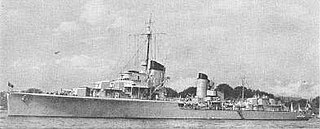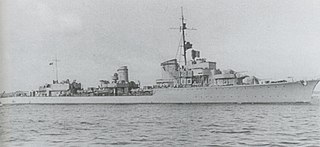
Operation Stonewall was an Allied naval and air operation in the Second World War from 26 to 27 December 1943, to intercept blockade-runners sailing to German-occupied France through the Bay of Biscay. Operations Barrier and Freecar, by the Allied navies and the Brazilian Air Force, had taken place in the south- and mid-Atlantic. The ships were tracked by OP-20-G and British code-breakers, which decrypted Japanese machine cyphers and German Enigma machine transmissions to U-boats and blockade-runners.

Z36 was one of five Type 1936B destroyers built for the Kriegsmarine during World War II. Completed in early 1944, the ship spent the war in the Baltic Sea, escorting German ships, laying minefields, and bombarding Soviet forces. On 12 December, a navigational error caused her to enter a German minefield as she was preparing to lay another minefield in the Gulf of Finland off the Estonian coast. Z36 struck a single mine and sank with the loss of all hands. The wreck was surveyed in 1994.

Z35 was the lead ship of her class of destroyers built for the Kriegsmarine during World War II. Completed in late 1943, the ship spent the war in the Baltic Sea, escorting German ships, laying minefields, and bombarding Soviet forces. On 12 December 1944, a navigational error caused her to enter a German minefield as she was preparing to lay another minefield in the Gulf of Finland off the Estonian coast. Z35 struck one or more mines and sank with the loss of all but 70 crewmen. The wreck was discovered and surveyed in 1994.

Z43 was a Type 1936B destroyer built for the Kriegsmarine during World War II. Completed in mid-1944, the ship spent the war in the Baltic Sea, escorting German ships, laying minefields, and bombarding Soviet forces. She participated in a minelaying operation in December 1944, where her sister ships Z35 and Z36 were sunk when they accidentally entered a German minefield. She was badly damaged by a mine on 10 April 1945, and scuttled on 3 May of that same year.

Z33 was a Type 1936A (Mob) destroyer built for the Kriegsmarine during World War II. Completed in 1943, the ship was damaged during the raid on the island of Spitsbergen in September and spent all of 1944 in Norwegian waters. She was damaged by British aircraft attacking the battleship Tirpitz in July. Z33 escorted troop convoys from northern Norway when the Germans began evacuating the area beginning in October. She ran aground in early 1945 as she was sailing for the Baltic and was badly damaged. While the ship was being towed to port for repairs, she and her escorts were attacked by Allied fighter-bombers. Z33 finally reached the Baltic in early April, but was reduced to reserve for lack of fuel. The ship was transferred to Cuxhaven and decommissioned shortly before the end of the war.

The German destroyer Z2 Georg Thiele was one of four Type 1934-class destroyers built for the German Navy (Kriegsmarine) during the mid-1930s. She was named after Georg Thiele, a Korvettenkapitän who commanded the Seventh Half Flotilla of torpedo boats. Completed in 1937, two years before the start of World War II, the ship spent most of her time training although she did participate in the occupation of Memel in early 1939.

Z20 Karl Galster was one of six Type 1936 destroyers built for the Kriegsmarine in the late 1930s. Completed in early 1939, the ship spent most of her time training. At the beginning of World War II in September, she was initially deployed to lay minefields off the German coast, but was soon transferred to the Skagerrak where she inspected neutral shipping for contraband goods. In late 1939 and early 1940, Z20 Karl Galster helped to laid three offensive minefields off the English coast that claimed one British destroyer, a fishing trawler, and twenty merchant ships. After a refit that prevented her from participating in the German invasion of Norway in April, the ship was sent to Norway for escort duties. Later that year Z20 Karl Galster was transferred to France, where she made several attacks on British shipping.

Z23 was one of fifteen Type 1936A destroyers built for the Kriegsmarine during World War II. Completed in 1940, the ship spent the war in Norwegian and French waters, escorting German ships and occasionally engaging Allied warships. In early 1941 she escorted ships between the Baltic and southern Norway before spending four months protecting ships as they transited through the Bay of Biscay. A few months after the Operation Barbarossa began in June, Z23 was transferred to northern Norway where she attempted to intercept one of the Arctic convoys returning from the Soviet Union and helped to lay several minefields.

Z24 was one of fifteen Type 1936A destroyers built for the Kriegsmarine during World War II. Completed in 1940, the ship spent the first half of the war in Norwegian waters. She was very active in attacking the Arctic convoys ferrying war materials to the Soviet Union in 1941–1942, but only helped to sink one Allied ship herself.

Z25 was one of fifteen Type 1936A destroyers built for the Kriegsmarine during World War II. Completed in 1940, the ship spent most of the war in Norwegian waters, escorting German ships and laying minefields, despite venturing to France in early 1942 for the Channel Dash, escorting two battleships and a heavy cruiser home through the English Channel. She was active in attacking the Arctic convoys ferrying war materials to the Soviet Union in 1941–1942 but only helped to sink one Allied ship.

Z27 was one of fifteen Type 1936A destroyers built for the Kriegsmarine during World War II. Completed in 1941, the ship was transferred to Norwegian waters later that year where she remained for most of the next several years, escorting convoys and laying minefields. She sank a Soviet oil tanker in late 1942 before sailing to Germany for a refit. Upon its completion in mid-1943, Z27 returned to Norway and participated in Operation Zitronella, the raid on the island of Spitsbergen in September.

Z28 was one of fifteen Type 1936A destroyers built for the Kriegsmarine during World War II. Built as a flotilla leader with fewer guns than her sister ships, she was completed in 1941. The ship spent most of the first few years of her service in Norwegian waters, escorting convoys and laying minefields. Z28 ran aground in early 1943 and spent the rest of the year under repair. The ship briefly returned to Norway at the beginning of 1944, but was transferred to the Baltic shortly afterwards to support minelaying operations in the Gulf of Finland. That was her primary focus through July and then she began escorting German cruisers as they bombarded Soviet troops ashore in addition to German convoys evacuating people from Finland and the Baltic States.

ZH1 was the lead ship of her class of four destroyers built for the Royal Netherlands Navy in the late 1930s. Originally named Gerard Callenburgh, the ship was scuttled while still incomplete by the Dutch during the German invasion of the Netherlands in May 1940, but she was salvaged by the Germans a few months later and commissioned in the Kriegsmarine in 1942 as ZH1.

The Battle of the Bay of Biscay, or Operation Bernau, was a naval action that took place on 28 December 1943 during World War II as part of the Atlantic campaign. The battle took place in the Bay of Biscay between two light cruisers of the British Royal Navy, and a destroyer and a torpedo boat flotilla of the German Kriegsmarine hoping to intercept and escort a blockade runner. The battle was fought as part of the Allied Operation Stonewall, which was to intercept German blockade runners off the west coast of France. In the confused action that followed the two British cruisers HMS Enterprise and HMS Glasgow respectively sank T26, together with her sister ship T25 and the destroyer Z27.

Z31 was a German Type 1936A (Mob) destroyer, which was completed in 1942 and served with the Kriegsmarine during the Second World War. She was constructed in Germany as part of Plan Z, and commissioned 11 April 1942. She spent much of the war in Arctic and Norwegian waters, taking part in the Battle of the Barents Sea on 31 December 1942. She survived the war, and was passed on to the French Navy as a war prize, serving under the name Marceau until 1958.

Z34 was a Type 1936A (Mob) destroyer built for the Kriegsmarine during World War II. Completed in 1943, the ship spent all of 1944 in Norwegian waters, and was twice damaged by British aircraft attacking the battleship Tirpitz. She escorted troop convoys from northern Norway when the Germans began evacuating the area beginning in October. Z34 was transferred to the Baltic with two of her sister ships at the beginning of 1945 and participated in the action of 28 January 1945 when they were intercepted off the Norwegian coast by a pair of British light cruisers. The ship was only lightly damaged during the battle and all three destroyers were able to disengage.

Z37 was a Type 1936A (Mob) destroyer built for the Kriegsmarine during World War II. Completed in 1942, the ship spent most of her brief career deployed in France. She participated in the Battle of the Bay of Biscay at the end of 1943 before she was accidentally rammed by the destroyer Z32 in early 1944. Towed back to port, the Kriegsmarine decided that Z37 was too badly damaged to repair and disarmed her hulk. Decommissioned later that year, she was scuttled by her crew before being scrapped by the French in 1949.

Z38 was a Type 1936A (Mob) destroyer built for the Kriegsmarine during World War II. She was laid down in 1941, and completed two years later. Her anti-aircraft armament was modified heavily under Project Barbara. She served with the 4th Destroyer Flotilla her entire time under German service, and spent much of her life escorting task forces, patrolling, laying mines, and bombarding land forces. She served in the Baltic briefly in 1943, before being reassigned to the Arctic area around Norway from 1943 to 1945, and then serving in the Baltic again in 1945.

The Z39 was a Type 1936A (Mob) destroyer built for Germany's Kriegsmarine during World War II. She was laid down in August 1940 and completed three years later. Her anti-aircraft armament was increased extensively during the war. Z39 served with the 6th Destroyer Flotilla her entire German career, which she spent escorting transports in the Baltic Sea, laying mines, and bombarding land forces. The destroyer served the navies of a total of three different countries: from 1943 to 1945 with the Kriegsmarine as Z39, from 1945 to 1947 with the US Navy as DD-939, and from 1948 to 1964 with the French Navy as Q-128.

The German torpedo boat T22 was one of fifteen Type 39 torpedo boats built for the Kriegsmarine during World War II. Completed in early 1942, the ship was transferred to France later that year where she escorted blockade runners and Axis submarines through the Bay of Biscay. T22 also laid minefields in the English Channel in mid-1943. She participated in the Battle of Sept-Îles, where she crippled a British destroyer, and the Battle of the Bay of Biscay later that year. After returning to Germany in early 1944, T22 struck a pair of mines in Narva Bay in August and blew up, with the loss of 143 men.















